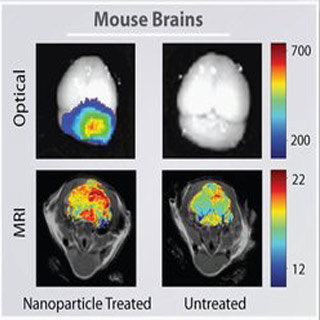
Researchers seemed to have illuminated the brain tumors by inserting fluorescent nanoparticles into the bloodstream. These nanoparticles appear to safely cross the blood-brain barrier. This barrier is known to be a roughly impenetrable barrier which protects the brain from infection. It was noted that the nanoparticles which remained in mouse tumors for nearly five days did not reveal any indication of damaging the blood-brain barrier.
The findings revealed that the nanoparticles seemed to have improved the difference in both MRI and optical imaging. Supposedly, MRI and optical imaging were used at the time of surgery. Also, severe cognitive problems appear to be a common side effect.
Lead author Miqin Zhang, a UW professor of materials science and engineering stated that, “Brain cancers are very invasive, different from the other cancers. They will invade the surrounding tissue and there is no clear boundary between the tumor tissue and the normal brain tissue.â€
“If we can inject these nanoparticles with infrared dye, they will increase the contrast between the tumor tissue and the normal tissue. So during the surgery, the surgeons can see the boundary more precisely. We call it ‘brain tumor illumination or brain tumor painting. The tumor will light up,†elucidates Zhang.
Zhang claimed that nano-imaging could also assist in detecting cancer at an early. It was believed that current imaging techniques have a greatest resolution of 1 millimeter. Thus, nanoparticles could improve the resolution by a factor of 10 or more thereby allowing the detection of smaller tumors and also treatment at an earlier stage.
It was observed that till today, nanoparticle which was used for imaging has been unable to cross the blood-brain barrier and particularly attach themselves to brain-tumor cells. However, with the assistance of recent techniques, doctors seem to inject dyes inside the body and use drugs in order to open the blood-brain barrier for a temporary period of time. Allegedly, this has a risk on the infection of the brain.
The UW team was believed to have overcome this challenge by creating a nanoparticle which remains small in wet conditions. It was estimated that the particle was nearly 33 nanometers in diameter when wet, and approximately one third the size of similar particles used in other parts of the body.
Evidently, crossing the blood-brain barrier depends on the size of the particle, its lipid, or fat content, and the electric charge on the particle. For this purpose, Zhang along with her colleagues built a particle which could pass through the barrier and reach tumors. They were noted to have used chlorotoxin in order to particularly target tumor cells. Chlorotoxin is known to be a small peptide isolated from scorpion venom. On the nanoparticle’s surface Zhang placed a small fluorescent molecule for optical imaging, and binding sites which could be utilized for attaching other molecules.
“Precise imaging of brain tumors is phenomenally important. We know that patient survival for brain tumors is directly related to the amount of tumor that you can resect. This is the next generation of cancer imaging. The last generation was CT, this generation was MRI, and this is the next generation of advances.” says co-author Richard Ellenbogen, professor and chair of neurological surgery at the UW School of Medicine.
Zhang hopes that future research will be able to assess the nanoparticle’s possibility for treating tumors. They hope to spot whether this ability could extend to brain cancer which appears to be the most common solid tumor mainly affecting the children.
The findings of the research have been published in the journal Cancer Research.
